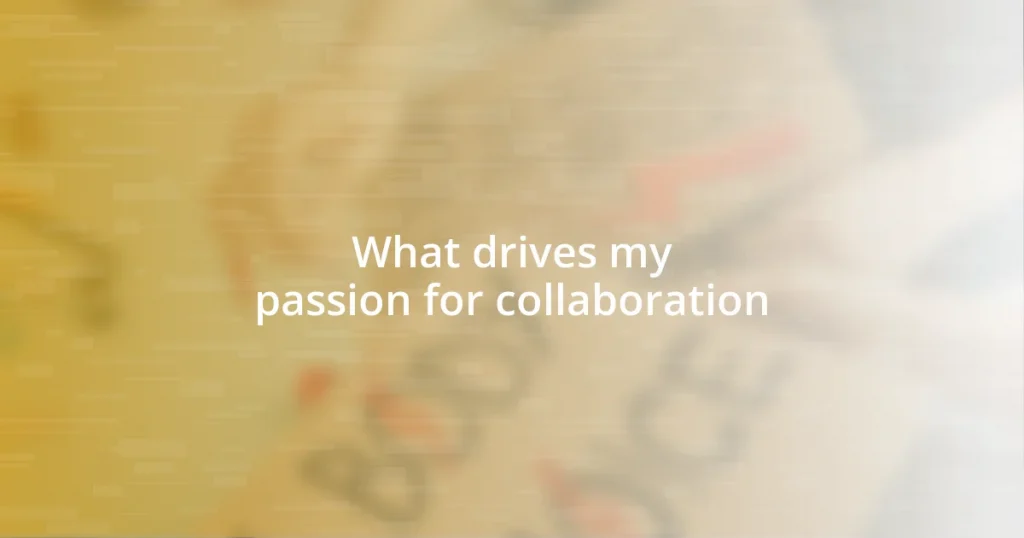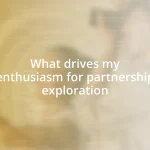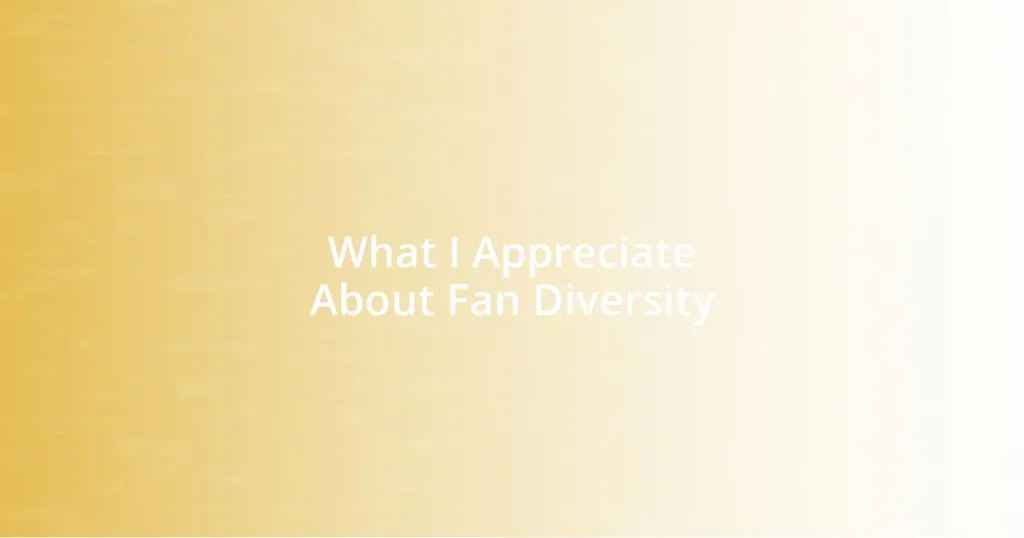Key takeaways:
- Collaboration thrives on trust, vulnerability, and open communication, enhancing creativity and fostering deeper connections among team members.
- Recognizing personal motivations for collaboration—such as connection, learning, and impact—can significantly contribute to successful teamwork.
- Utilizing effective tools and strategies, along with celebrating small wins, strengthens collaborative efforts and builds a positive team environment.
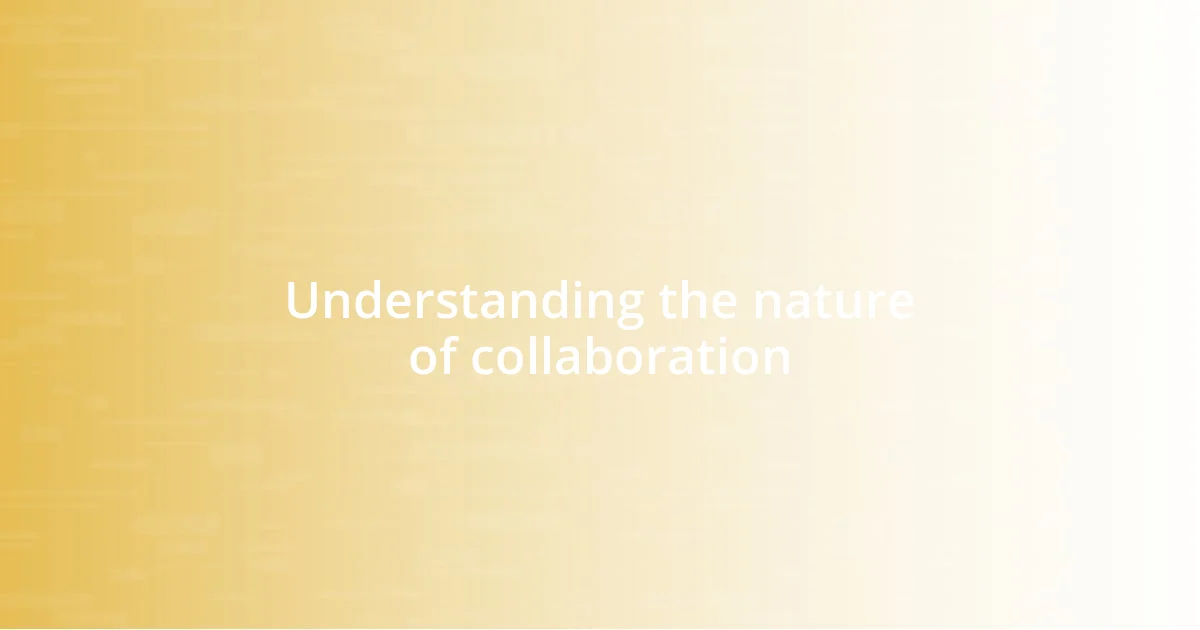
Understanding the nature of collaboration
Collaboration is more than just working alongside others; it’s about blending diverse skills and perspectives to create something greater than ourselves. I vividly remember a project where my team faced seemingly insurmountable challenges. Each member had their strengths, but it wasn’t until we openly shared our ideas and actively listened to one another that we discovered innovative solutions we couldn’t have reached individually. Isn’t it fascinating how a simple conversation can unlock collective creativity?
At its core, collaboration requires vulnerability and trust. I’ve often found that when I express my concerns or uncertainties, my colleagues feel empowered to do the same. This mutual openness transforms the group dynamic, fostering an environment where everyone feels valued. It makes me wonder—how often do you hold back your thoughts in a team setting? I can’t emphasize enough how sharing those hesitations can lead to richer discussions and unexpected breakthroughs.
Moreover, collaboration thrives in an atmosphere of respect and shared goals. During one project, we established clear objectives and agreed to support each other’s expertise. This alignment not only fueled our motivation but also cultivated a sense of belonging. Have you ever experienced that exhilarating moment when everyone is literally on the same page? That synchronicity, in my experience, is the heart of collaboration, driving us to achieve outcomes we could only dream of alone.
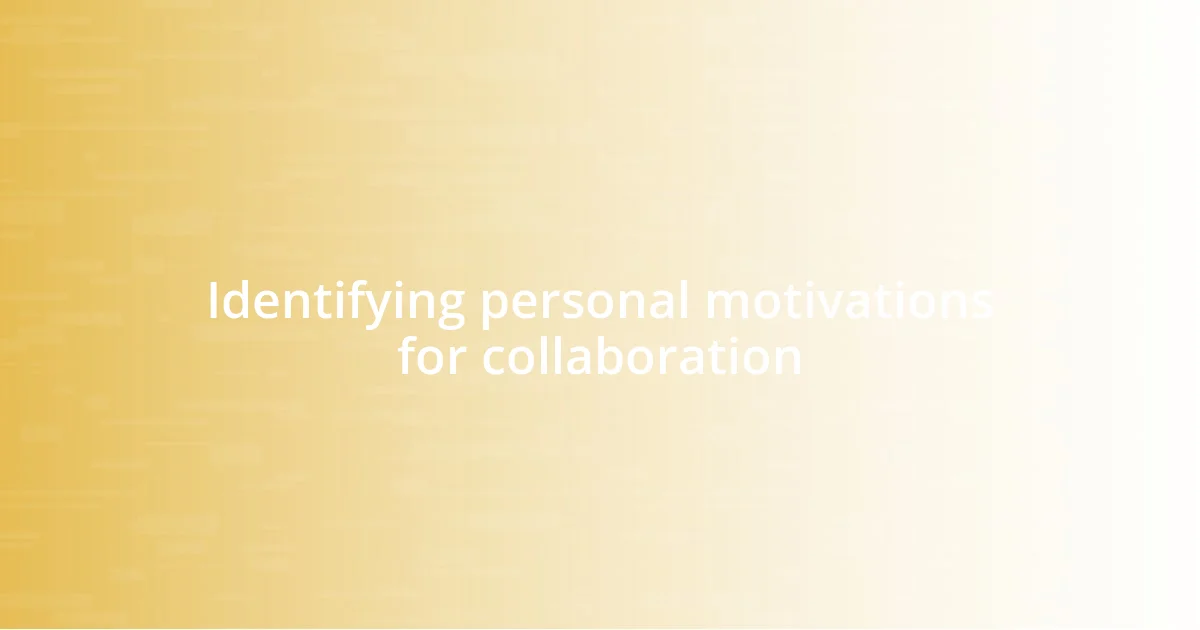
Identifying personal motivations for collaboration
Identifying my personal motivations for collaboration often begins with understanding my desire for connection. I thrive when I get to know my teammates on a deeper level. For example, during a recent brainstorming session, I made it a point to learn about each person’s unique background and interests. Not only did it spark deeper conversations, but it also created a stronger bond among us. It’s an incredible feeling when you realize that collaboration can foster not just professional connections but also friendships that enrich our work lives.
Another key motivation for me is the potential for shared learning. I often reflect on moments when I’ve learned something invaluable from a colleague’s perspective. Last month, I worked with someone who excelled in graphic design—a field I’m not particularly familiar with. Their insights helped me appreciate the nuances of visual storytelling. It was a lightbulb moment! Have you ever had a revelation that changed your approach to a project? I find that these moments of learning fuel my passion for collaboration, making me eager to engage with others.
Lastly, I am driven by the impact that collaborative efforts can have on the final outcome. Each successful project reinforces my belief in collective strength. I recall a challenge where my team was on a tight deadline. Instead of panicking, we divided tasks based on individual strengths and tackled them together. The rush of watching everything come together—like pieces of a puzzle—was exhilarating. Isn’t it empowering to realize that our varied contributions can lead to something extraordinary? This sense of achievement is precisely what motivates me to collaborate.
| Motivation | Example |
|---|---|
| Connection | Deepening relationships with teammates through shared interests |
| Learning | Gaining new insights from colleagues’ unique skills |
| Impact | Feeling empowered by successful joint efforts and outcomes |
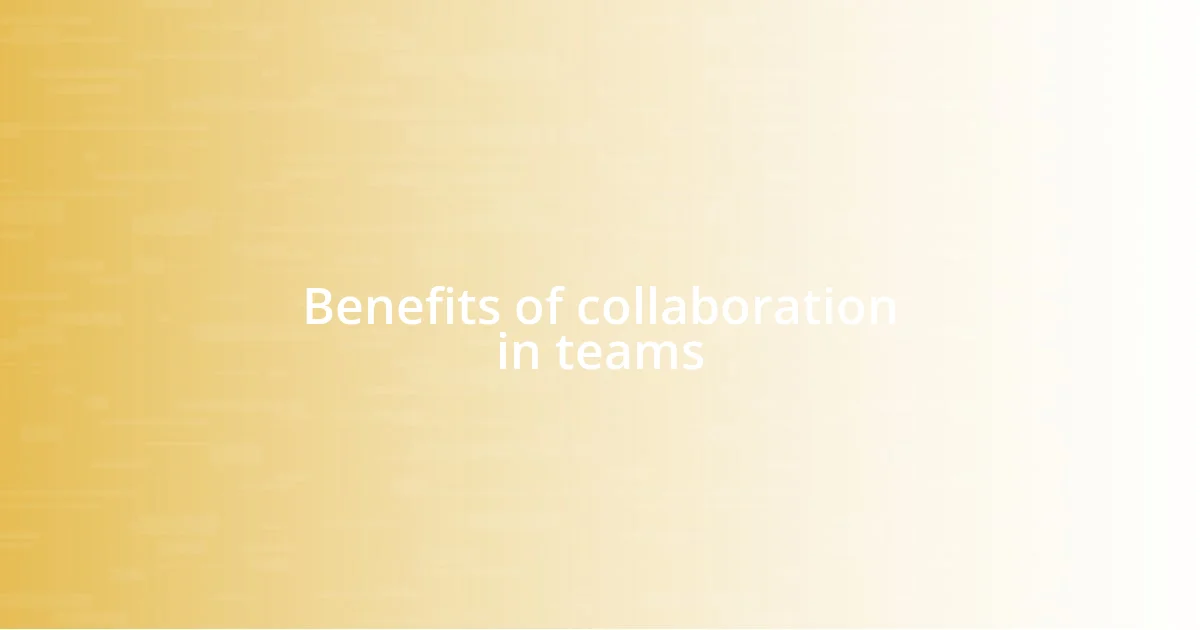
Benefits of collaboration in teams
Collaboration in teams opens up a world of benefits that often surprise me. During one project, I noticed how diverse perspectives led to unexpected solutions. It reminded me that when we converge our thoughts, creativity flourishes. Team collaboration is not just about pooling ideas; it’s a powerful catalyst for innovation, problem-solving, and overall productivity.
Here are some key benefits I’ve observed over time:
- Enhanced Creativity: When diverse minds come together, they create a melting pot of innovative ideas.
- Effective Problem-Solving: Collaboration allows teams to tackle challenges from various angles, leading to more comprehensive solutions.
- Increased Engagement: Working together fosters a sense of ownership and accountability among team members.
- Skill Development: Team collaboration often exposes individuals to new skills and knowledge, enriching their professional growth.
- Stronger Relationships: Collaborative efforts can deepen trust and camaraderie, making work more enjoyable.
I’ve found that the emotional connections formed through collaboration are just as valuable as the practical outcomes. In another project, I recall moments of celebration and even shared frustration, which brought us closer as a team. Those experiences cultivated a camaraderie that made tackling challenges together even more fulfilling. Wouldn’t you agree that those bonds are integral to both personal satisfaction and team success?

Building effective communication strategies
Effective communication strategies are the bedrock of any successful collaboration. I vividly remember a time when a poorly timed email led to confusion in a project I was managing. It was a wake-up call to me about the importance of clear, direct communication. I realized that having regular check-ins can make a world of difference—it provides a platform to clarify expectations and keep everyone on the same page. How often do you find yourself assuming everyone understands the plan?
Another aspect I’ve found crucial is adapting to the communication styles of team members. During a collaborative project, I noticed that some teammates preferred visual aids while others thrived on detailed reports. By catering to these preferences, I witnessed a significant increase in engagement and understanding. It turns out that being versatile in how we communicate can unlock the full potential of the team’s talents. Have you ever encountered a situation where the right approach changed the outcome of a discussion?
Lastly, embracing feedback as a tool for improvement has been a game-changer in my collaborations. I once led a creative workshop where I actively sought thoughts from participants after each session. The insights shared allowed me to adjust my approach in real-time, fostering an environment where everyone felt their voice mattered. This practice not only enhanced our creative output but also built trust within the team. Isn’t it refreshing to be part of a team where continuous growth is celebrated, rather than feared?
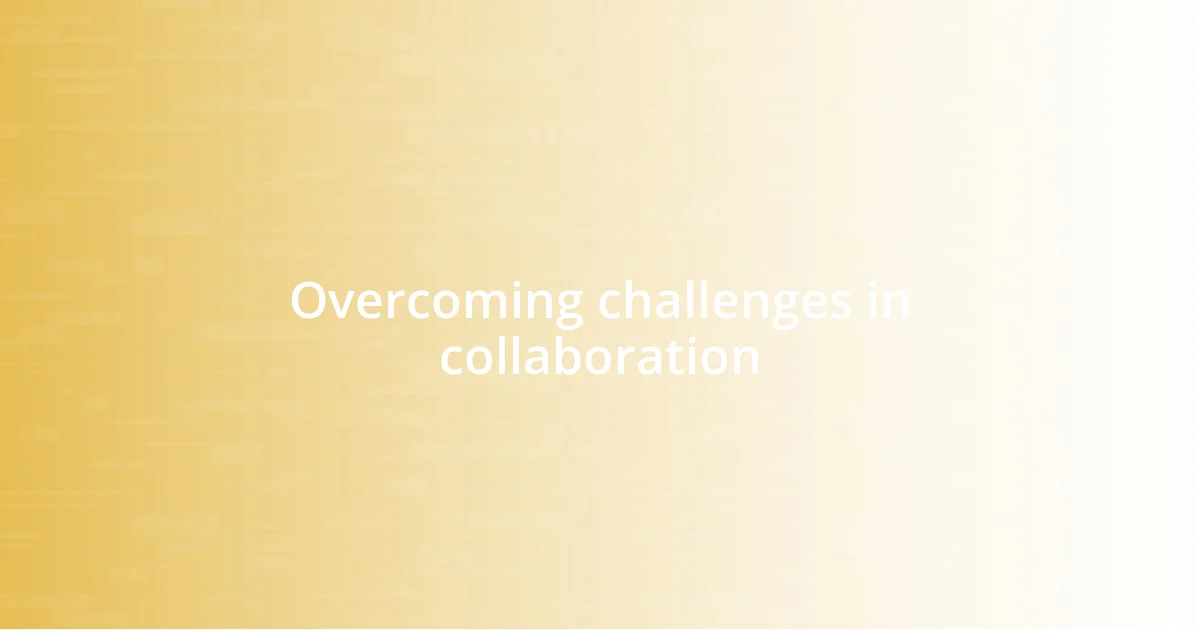
Overcoming challenges in collaboration
Collaboration often comes with its own set of challenges, but I’ve learned that recognizing these hurdles is the first step in overcoming them. There was a time when a miscommunication almost derailed an important project I was part of. It made me realize just how crucial it is to establish clear roles and responsibilities early on. When everyone knows their part in the larger picture, it not only streamlines the process but also minimizes misunderstandings. Have you ever found yourself in a similar situation where clarity made all the difference?
I also find that emotional intelligence plays a vital role in navigating team dynamics. In one instance, a team member was struggling with their workload, and instead of brushing it aside, we made it a point to check in regularly. By fostering an environment where everyone felt comfortable sharing their challenges, we were able to tackle those issues together. The growth in trust and open dialogue among us was astounding. Have you noticed how addressing feelings can transform collaboration?
Lastly, it’s important to embrace adaptability when faced with setbacks. During a recent group project, an unexpected change of direction required us to pivot quickly. Initially, it felt overwhelming, but by encouraging a mindset of flexibility within our team, we turned the challenge into an opportunity for creativity. I’ve come to believe that the ability to reassess and regroup is key in collaboration. What about you—how do you respond when plans suddenly shift?

Tools to enhance collaborative efforts
Investing in the right tools can significantly amplify our collaborative efforts. I recall using project management software for the first time during a major initiative; it felt like flipping a switch. Suddenly, we had a centralized space for tasks, deadlines, and updates, which drastically reduced the chaos of miscommunication. Have you experienced that moment when a tool just clicks?
Another tool that’s been invaluable in my collaborations is a shared digital whiteboard. During brainstorming sessions, the ability to sketch ideas collaboratively in real-time fosters creativity and open dialogue. I remember one such session where everyone contributed their thoughts visually, leading to breakthroughs we hadn’t anticipated. It’s fascinating how technology can transform our collective thinking process, isn’t it?
Lastly, I’ve come to appreciate the importance of communication apps that allow for instant feedback and dialogue. I once led a project where our team relied heavily on a messaging platform for quick check-ins. This immediate form of communication not only kept everyone engaged but also helped us tackle issues as they arose. It made me realize just how integral it is to have platforms that support spontaneous collaboration—after all, ideas often arise in the most unexpected moments, don’t they?

Cultivating a collaborative mindset
To cultivate a collaborative mindset, I believe it’s essential to start by nurturing curiosity about others’ perspectives. I once found myself in a group where differing viewpoints could have led to conflict. Instead, we decided to explore each other’s ideas in depth. I was genuinely amazed at how much richer our solutions became just by asking questions and actively listening. Have you ever felt that a simple inquiry could shift the atmosphere in a team?
Another aspect that has greatly influenced my attitude towards collaboration is the practice of vulnerability. Opening up about my own struggles has often encouraged others to do the same. I recall a project where I shared my hesitations about our direction. Instead of feeling exposed, I found that it strengthened our bond and allowed us to build on shared concerns. It’s truly enlightening how being authentic can break down barriers, don’t you think?
Lastly, I prioritize celebrating small wins with my collaborators. In a recent endeavor, we took a moment after each milestone to acknowledge everyone’s contributions. Those little moments of recognition shifted our energy, reinforcing the value of teamwork. It’s heartening to see how far appreciation can go in fostering a positive environment; have you tried this approach in your collaborations?










